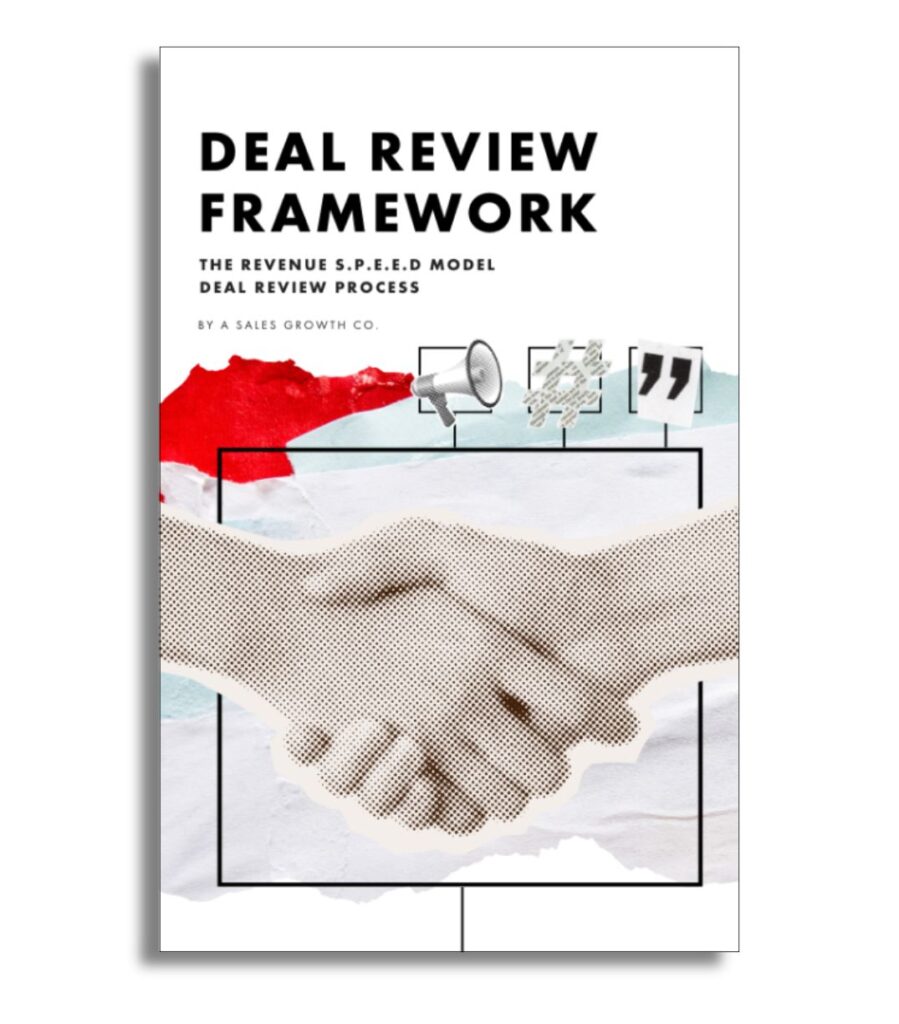Deal scoring is a method for evaluating the health and quality of sales opportunities using defined inputs. It’s used to assess which deals are real, which ones are at risk, and which are unlikely to close.
A strong scoring system gives sales teams a structured way to prioritize work, improve coaching, and make more accurate forecasts (only 45% of sales organizations trust their forecast according to Gartner). But not all scoring models are created equally. Some rely heavily on activity tracking or subjective stage progression. Others lack a clear connection to the buyer’s intent to change.
This article explains how to build and apply a deal scoring system centered on buyer input. It outlines the core components to score, how to structure the model, and how to use scoring data to guide pipeline reviews and forecast decisions.
Key Takeaways
- Deal scoring measures opportunity health using specific buyer discovery inputs.
- A complete model includes five areas: problem, root cause, impact, buying process, and commitment.
- Scores should be clearly defined and applied consistently across opportunities.
- Use scoring to guide deal reviews, evaluate pipeline quality, and inform forecast decisions.
- Track performance through win rates, forecast accuracy, sales velocity, coaching outcomes, and CRM data quality.
What Deal Scoring Measures
Deal scoring evaluates the strength of a sales opportunity using specific discovery inputs from the buyer. It shows which opportunities are most likely to close, which ones are at risk, and which lack the information needed to move forward.
A complete scoring model covers five areas:
Business Problem
A specific, buyer-confirmed problem has been identified. The issue is tied to a measurable business outcome.
Root Cause
The underlying cause of the problem is clear. The buyer acknowledges this as the source of the issue.
Impact and Cost of Inaction
Business consequences are quantified. The buyer has acknowledged the risk of staying in the current state.
Buying Process and Stakeholders
The path to purchase is documented. Key decision-makers are involved. Evaluation criteria and internal process steps are clear.
Next Steps and Commitment
A concrete next step has been confirmed. The buyer has made an active commitment to move forward. Any risks of delay or indecision are identified.
Scoring provides a simple way to rank opportunities based on the completeness and quality of this information. Higher-scoring deals have clearer buyer alignment and a stronger chance of closing. Lower-scoring deals highlight where coaching or further discovery is needed.
How to Structure the Scoring Model
A scoring model should be simple to understand, easy to apply, and directly tied to the information that matters most: what the buyer has shared during discovery. Each component: problem, root cause, impact, buying process, and commitment, can be scored individually. The combined score gives managers and reps a clear view of deal quality.
Step 1: Use Binary or Tiered Criteria
Each scoring element should be measurable. Avoid vague ratings. Choose one of two structures:
Binary: Yes/No or Complete/Incomplete (e.g., “Root cause identified?”)
Tiered: Score each input on a defined scale (e.g., 0–3, where 0 = missing, 3 = confirmed and quantified)
Keep the scoring logic consistent across deals and reps.
Step 2: Apply Weighting (Optional)
Not all inputs carry the same importance. For example:
Buyer-confirmed business problem and impact may be weighted higher than stakeholder documentation. If using tiered scoring, assign multipliers to high-impact categories. This adds complexity but can improve scoring precision.
Step 3: Define Score Ranges
Create clear thresholds for interpreting scores. For example:
80–100%: High confidence — strong evidence of buyer need and intent
50–79%: Moderate confidence — discovery gaps to resolve
Below 50%: Low confidence — opportunity not qualified for pipeline
You can also use a traffic-light system (Green / Yellow / Red) or letter grades (A / B / C) depending on preference.
Step 4: Document Expectations
Reps should know exactly what qualifies as a “complete” answer. Use examples and templates to define what good looks like across each scoring category. This ensures consistency and reduces subjectivity.
Score Thresholds in Practice
Score categories reflect how complete and buyer-validated a sales opportunity is. Each range signals a different level of deal health and forecast confidence:
Green (75% and above)
These deals have most, if not all, scoring fields complete with detailed inputs directly from the buyer. The business problem is confirmed, the root cause is clear, the impact is quantified, the buying process is mapped, and a next step is scheduled. These are high-confidence opportunities with strong alignment and a high likelihood of closing.
Yellow (55%–74%)
Some critical information is missing or only partially confirmed. The problem may be loosely defined, the impact unclear, or stakeholder involvement limited. These deals show potential but need more discovery or manager coaching to move forward.
Red (Below 55%)
These opportunities lack core inputs. There’s little to no evidence that a problem exists, and the buyer’s motivation to act is uncertain. These should not be included in the forecast and should be requalified or paused until further information is gathered.
Organizations using this scoring model have seen consistent performance patterns(shoutout Noted Analytics):
- Green deals closed 61% of the time and averaged $277,000 in annual contract value.
- Yellow deals closed 17% of the time with an average value of $157,000.
- Red deals closed just 7% of the time, with average value dropping to $117,000.
Additional trends reinforce the scoring thresholds:
- Closed-won deals had 92% field coverage; lost deals averaged just 49.6%.
- Winning deals moved through the pipeline in 74 days on average, while lost deals remained open for over 143 days.
How to Use Deal Scores in Reviews and Forecasts
Once a scoring model is in place, the next step is operationalizing it. Scores should be used consistently to guide deal reviews, evaluate pipeline health, and inform forecast calls. This ensures that opportunity decisions are based on evidence, not assumptions.
Deal Reviews
Scoring brings structure to what can otherwise become subjective status updates. Use the score to focus the review:
- Identify missing or incomplete discovery inputs.
- Ask questions based on score gaps (e.g., “What’s the root cause they confirmed?” instead of “How’d the call go?”).
- Prioritize coaching toward the lowest-scoring inputs in each opportunity.
This approach improves deal hygiene and reinforces discovery expectations across the team.
Pipeline Management
Scores provide a reliable view of which deals belong in the pipeline. Use scoring thresholds to:
- Flag deals that don’t meet the qualification standard.
- Prevent unscored or low-scoring opportunities from advancing stages.
- Filter pipeline views by score category to monitor quality, not just quantity.
Adding this layer improves pipeline accuracy and reduces time wasted on unqualified deals.
Forecasting
Forecasts should reflect deals with verified buyer commitment. Score data helps differentiate between real pipeline and padded numbers.
Recommended practices:
- Use score ranges to establish forecast eligibility.
- Require a minimum score or completed inputs before a deal can be included.
- Segment forecast confidence by score (e.g., only “high-confidence” deals contribute to commit).
This reduces the likelihood of last-minute surprises and improves forecast reliability over time.
How to Measure the Effectiveness of Deal Scoring
A scoring model is only useful if it drives better pipeline decisions and improves forecast reliability. To evaluate its impact, review these indicators regularly:
1. Win Rate by Score Range
Compare close rates across score bands. High-scoring deals should convert at a higher percentage than those with incomplete or missing inputs.
2. Forecast Accuracy
Look at forecasted revenue versus actual closed revenue. Consistent use of score thresholds should reduce variance and improve predictability over time.
3. Sales Cycle Length
Analyze the time it takes to close deals by score range. Opportunities with strong discovery early in the cycle typically close faster.
4. Score Distribution
Check how your pipeline is distributed across score categories. A functional model will surface a healthy mix of deal types, not a pipeline filled with unqualified or artificially inflated scores.
5. Coaching Effectiveness
Track whether low scores improve after intervention. If coaching is aligned to the scoring model, deal quality should increase as inputs are addressed.
6. CRM Data Quality
Audit the fields tied to scoring. Incomplete or vague entries signal a need for reinforcement or better training around what’s expected.
When scoring is implemented correctly, it becomes a core part of opportunity management. It replaces guesswork with inspection, aligns coaching to real gaps, and improves decision-making across the pipeline.
Final Thoughts
A well-defined scoring model strengthens opportunity management by showing which deals are viable and which require more discovery. It supports better coaching, improves forecast accuracy, and provides a clear standard for qualification. By focusing on what matters to the buyer, scoring removes guesswork and brings consistency to pipeline decisions.




0 Comments